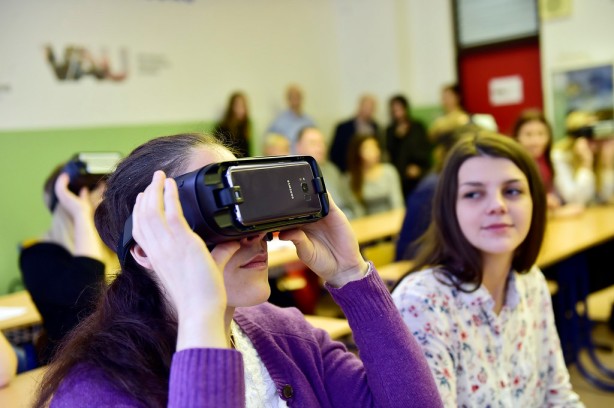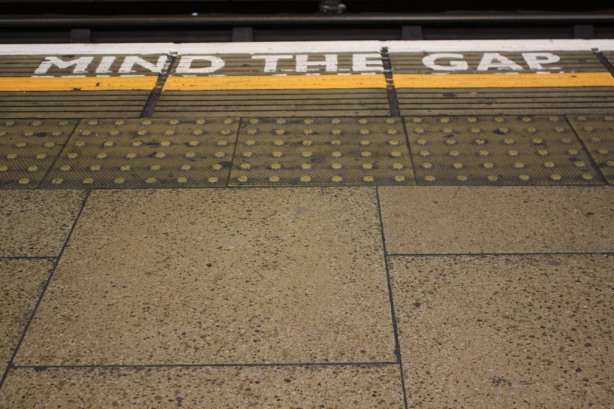
Photo Credit: <a href=”https://www.flickr.com/photos/46944516@N00/36957597632/”>pedrosimoes7</a> Flickr via <a href=”http://compfight.com”>Compfight</a> <a href=”https://creativecommons.org/licenses/by/2.0/”>cc</a>
From Fiction to Reality
In the future, George Orwell imagined that there would be telescreens, speakwrite and printed postcards, much like computers, CCTV cameras and emails of today (Orwell, 1949). In 1985, Back to the Future predicted flying cars, hoverboards, fingerprint recognition and wearable technology. In Dave Eggers’ book “The Circle”, he described data sharing, public transparency and the ultimate connectivity through responsive wearables and smart objects. More recently in Ernest Cline’s book “Ready Player One”, we see students attend virtual schools as avatars in a dystopian world via VR headsets. How accurate and relevant are these “predictions” and are they more fiction than reality? Examining the Horizon report helps us to see what technologies already exist and which possibilities are just around the corner. Through its report, we can ascertain the necessary steps schools will need to take and investigate how to prepare our students for a future world we cannot yet know.
A Relevant Education
Traditionally the purpose of school has been about academic success. Conversely, schools like UWCSEA have developed a holistic programme, but academics are still the focus and grades remain important when transitioning from High School to University. But do academics prepare our students for survival in the future world? What is authentic learning and a relevant education in 2018? Ken Robinson argues that “creativity, innovative and interpersonal skills and social sensitivity” are the fundamental skills needed (Robinson, 2017). There is never a more relevant time for changing the way students learn with so much technology at their fingertips. As the world of connectivity evolves and the need for innovative and creative entrepreneurs are ever more required, schools need to change. Out with the prescribed curriculum, standardised tests and end terminal examinations and in with digital literacies, multimodality and collaborative learning. Robinson talks about the past when practical and vocational subjects taught the skills that were needed for the workforce (Robinson, 2017). What skills are needed for our emerging world? Creative thinking and innovation have often been under-supported, but they couldn’t be more needed to help solve world problems in our ever growing planet and overwhelmed environment and infrastructure. But as technology threatens to take over our every chore, we need to educate students on surviving the pressures of today with strategies to cope with distractions and peer pressure, safety online and digital citizenship. There is a demand for digital fluencies (Crockett and Churches, 2017) to be compulsory within education norms. Web literacy is a basic skill when reading, writing and participating on the internet. Students need to be taught how to navigate, participate and to synthesize information in order to make sense of it and apply it. It is no longer enough to be solely an acquirer of knowledge; one needs to participate to learn effectively in today’s connected society (Sfard, 1998). But along with this comes pressure and they need to be helped in finding balance and develop strategies through positive role models. By humanising education through personalised learning the rewards will be empowered and intrinsically motivated individuals.
Real-world learning
As one reads the most recent Horizon Report, there are trends of technology in education that continue to feature in their ongoing research. Digital literacy, personalised learning and deep learning have been core areas of study over the past 5 years. More recently the popularity of STEAM, coding, learning spaces and virtual reality have been investigated. (Freeman, Adams Becket, Cummins, Davis & Hall Giesinger, 2017). Many schools have introduced coding for learning across their curriculum and Makerspaces support the rise of STEAM to reflect the skills needed for the world in which we live now.
Schools are responding to the changing curriculum by looking at how to incorporate digital tools effectively within the existing learning environment. Mobile technology aids this transition, with tablets and phones but with this comes distraction and information overload.
Gamification is not a new learning theory and gamified approaches have long since featured in a teacher’s toolkit. Spurred on by Jane McGonigal’s TED talk, “Gaming can make a better World”, wider understanding and acceptance of the power of games and game-based learning led to the development of apps like Quizlet and Duolingo where learning is personalised and adaptable both in the classroom and at home.
The popularity of learning through YouTube over the past 10 years or more has enabled the medium of video to become a hive of activity for both consumers and creators. Individuals have become more open to direct their own learning and as a result online courses through EdX, Coursera, Udemy or MOOCs, have risen in popularity. My own experience of online engagement courses has been motivational, as I can choose a course which meets my needs at a time that best suits me. Practices of flipping classrooms and using videos within apps like Edpuzzle are becoming more usual practices. Similarly, teacher-monitored study sites and mobile apps like MyiMaths, Quizlet and Doddle help integrate person-centred learning opportunities alongside traditional teaching methods. Personalised learning has to be key in the future, where individual needs are understood and digital tools are chosen to improve differentiation. Students will need to become more self-directed learners in order to be motivated to drive their own learning and upskilled for the world of tomorrow.

Photo Credit: Bratislavsky kraj Flickr via Compfight cc
Emerging Technology
In the Horizon report, virtual reality (VR) features heavily as emerging technology for schools. But “it will take a few years before VR becomes vital to schools around the world.” (Freeman et al., 2017, p.46). As an example of experiential learning, VR has much potential to help students understand and immerse themselves in an environment, situation or place. Google Expeditions has been successful in classrooms as a cheap and simple option when starting out with immersive technology. Being able to step into another world and experience life in another culture or underwater brings the unreachable into the classroom. Simulations prove fun and engaging and this aspect of VR is seen as a potential direction for schools. Relevant world experiences, whether real or virtual, engage and help deeper and authentic learning. In Michael Bodekaer’s TED demonstration of a virtual science lab, he explains how important the education of today’s generations of scientists is in solving world issues such as population growth, health and the environment. He sees immersive technology as a tool to engage and understand difficult concepts and situations to reimagine learning as we know it (Bodekaer, 2015). Apps like Google’s Tilt Brush take VR to the next level. The possibilities are endless but, as it is still in its infancy, we are, as yet, limited in the examples of schools successfully integrating VR into the classroom. The next 12 months will be crucial in changing this shift, as technology evolves and becomes more viable economically and practically.
Focus on Fluencies
With the increasing advancements in technology, there is a growing need to embed the teaching of digital fluencies. Linked to this, in his book “Creative Schools”, Robinson says that we should be teaching students 8 core competencies: curiosity, creativity, criticism, communication, collaboration, compassion, composure and citizenship (Robinson, 2015). To be able to critically question, develop innovative ideas and solve complex problems are crucial skills that build students capabilities to live and work in a future world. As schools change and adapt so must teachers themselves will need to keep abreast of these new literacies.
With these competencies in mind, Director of IT at UWCSEA, Ben Morgan, says schools need to focus on what is needed right now and the relevant technologies that can help us to learn most efficiently. He says that he sees “great examples of using technology all over the College, but what I would love is for the best of that to be in use everywhere” (B. Morgan, personal communication, January 20, 2018). An example of this is the use of Teamie, an online learning platform, used for discussion, sharing of resources, feedback and ongoing formative assessment. If all teachers employed it consistently, then all students would use it effectively, resulting in deeper learning. Only then should we move on to other emerging practices and tools that support learning and enhance digital literacy. Digital fluency has never been more important and, rather than continuing to chase the next best thing, schools should focus on what is the right technology for their students and fully embed it in the curriculum.

Photo Credit: Pickersgill Reef Flickr via Compfight cc
With advancement comes balance. As students live increasingly sedentary lives, the importance of play and spending time outside will become even more important. The benefits of play are clear in early years but also for older children: play builds skills in collaboration, tolerance and persistence and the Lego Learning Institute cites play as “an essential ingredient to fuel creativity and capacity as learners” (Whitebread, Ackermann, Gauntlett, Wolbers, Weckstrom, 2012).
Whilst online communities and gaming sites allow for collaboration and communication, face to face interactions are still a crucial part of developing relationships. Whitebread talks about the risks attached to play deprivation and how “children’s cognitive development and emotional well-being” is related to the quality of play. When play is taken away or reduced, so too does cognitive functioning and social and emotional development (Whitebread et al., 2012). Bringing play back to the classroom will bring benefits as well as balance.
Deep Learning
Schools need to change to be relevant. By focussing on a culture of innovation, deeper learning will follow (Freeman et al., 2017). In “Different schools for a Different World”, Scott Mcleod and Dean Shareski talk about the big shifts in deeper learning schools and innovative organisations. These are: changing thinking approaches to school; higher level thinking such as creativity, innovation and problem solving; student agency including personalisation and differentiation; authentic work; technology infusion such as global connections and online environments; and “robust tech integration” (McLeod and Shareski, 2018). They cite schools that are fostering deeper learning including High School High, Surrey Academy of Innovative Learning and New Tech High with projects incorporating communication, collaboration, critical thinking and technical proficiency alongside relevant, real-world situations and in flexible learning environments. (McLeod and Shareski, 2018).
Closing the Digital Divide
With rapid advances in technology, concerns must be raised of the digital divide. How do we lessen this gap whilst technology advances so rapidly? How do children in impoverished areas develop these skills? Is the divide between the rich and poor widening with regard to digital literacy? When will access to technology be free and available to all, so that consumers can become creators no matter their culture, status, age or upbringing? How could schools and communities help towards digital inclusion?
With the dawn of a new era of modern media, who will be left behind to widen the gap even further? Should it not be a human right to have access to modern technology.

Photo Credit: spin’n’shoot Flickr via Compfight cc
References
Bodekaer, M. (n.d.). This virtual lab will revolutionize science class. Retrieved from https://www.ted.com/talks/michael_bodekaer_this_virtual_lab_will_revolutionize_science_class
Brown, A., & Green, T. (2016, 06). Virtual Reality: Low-Cost Tools and Resources for the Classroom. TechTrends, 60(5), 517-519. doi:10.1007/s11528-016-0102-z
Crockett, Lee, and Andrew Churches. Mindful Assessment: the 6 Essential Fluencies of Innovative Learning. Solution Tree Press, 2017
Cline, E. (2011). Ready player one. New York: Crown Publishers.
Eggers , D. (2013). The Circle: A Novel. New York, NY: Alfred A. Knopf.
Freeman, A., Adams Becker, S., Cummins, M., Davis, A., and Hall Giesinger, C. (2017). NMC/CoSN Horizon Report: 2017 K–12 Edition. Austin, Texas: The New Media Consortium.
Mcdonald, D. (2017). The Future Belongs To Those Who Prepare For It Today: How The Nmc Horizon Report (Higher Education Edition) Can Help You Plan Your Institutions Technological Future. EDULEARN17 Proceedings. doi:10.21125/edulearn.2017.0572
Orwell, G. (1949). Nineteen Eighty-Four.
McGonigal, J. (n.d.). Gaming can make a better world. Retrieved from https://www.ted.com/talks/jane_mcgonigal_gaming_can_make_a_better_world
McLeod, S., & Shareski, D. (2018). Different schools for a different world. Solution Tree Press, a division of Solution Tree.
Resnick, M. (2012). Let’s teach kids to code. Retrieved from https://www.ted.com/talks/mitch_resnick_let_s_teach_kids_to_code
Robinson, K. (n.d.). Changing education paradigms. Retrieved from https://www.ted.com/talks/ken_robinson_changing_education_paradigms
Robinson, K., & Aronica, L. (2016). Creative schools: The grassroots revolution that’s transforming education. Penguin Books.
Sfard, A. (1998, 03). On Two Metaphors for Learning and the Dangers of Choosing Just One. Educational Researcher, 27(2), 4. doi:10.2307/1176193
Strulle, A. D., & Psotka, J. (n.d.). Educational Games and Virtual Reality. Leadership in Science and Technology: A Reference Handbook, 824-832. doi:10.4135/9781412994231.n94
- (2017, January 27). Sir Ken Robinson – The Learning Revolution, BETT 2017 – PART 1. Retrieved from https://www.youtube.com/watch?v=IMqW79LQS98
The Future of Play. (n.d.). Retrieved from http://www.legofoundation.com/ko-kr/research-and-learning/foundation-research/the-future-of-play
The Promise of Virtual Reality in Higher Education. (n.d.). Retrieved from https://er.educause.edu/articles/2016/3/the-promise-of-virtual-reality-in-higher-education
Tong, V. (2017, August 23). How Virtual Reality Takes Immersive Contemporary Art to the Next Level. Retrieved from https://theartling.com/en/artzine/2017/08/23/how-virtual-reality-takes-immersive-contemporary-art-to-the-next-level/
Virtual Reality Is for Artists. (n.d.). Retrieved from http://time.com/vr-is-for-artists/
Wegerif, R., & Mansour, N. (2010). A Dialogic Approach to Technology-Enhanced Education for the Global Knowledge Society. New Science of Learning, 325-339. doi:10.1007/978-1-4419-5716-0_16
Whitebread, D., Basilio, M., Kuvalja, M. & Verma, M. (2012). The importance of play: a report on the value of children’s play with a series of policy recommendations. Brussels, Belgium: Toys Industries for Europe








